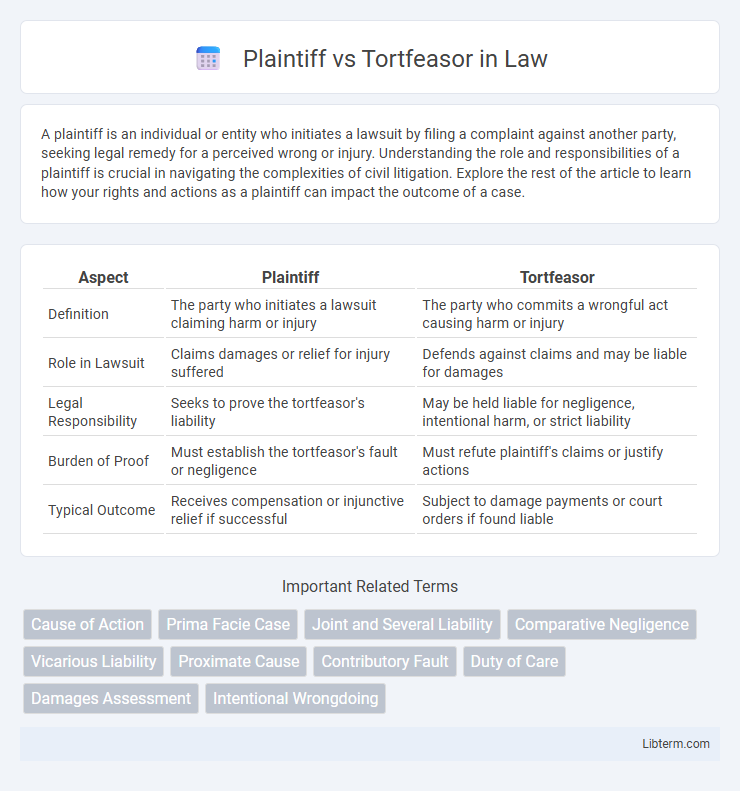A plaintiff is an individual or entity who initiates a lawsuit by filing a complaint against another party, seeking legal remedy for a perceived wrong or injury. Understanding the role and responsibilities of a plaintiff is crucial in navigating the complexities of civil litigation. Explore the rest of the article to learn how your rights and actions as a plaintiff can impact the outcome of a case.
Table of Comparison
| Aspect | Plaintiff | Tortfeasor |
|---|---|---|
| Definition | The party who initiates a lawsuit claiming harm or injury | The party who commits a wrongful act causing harm or injury |
| Role in Lawsuit | Claims damages or relief for injury suffered | Defends against claims and may be liable for damages |
| Legal Responsibility | Seeks to prove the tortfeasor's liability | May be held liable for negligence, intentional harm, or strict liability |
| Burden of Proof | Must establish the tortfeasor's fault or negligence | Must refute plaintiff's claims or justify actions |
| Typical Outcome | Receives compensation or injunctive relief if successful | Subject to damage payments or court orders if found liable |
Introduction to Plaintiff and Tortfeasor
The plaintiff is the party who initiates a lawsuit seeking legal remedy for harm or injury caused by another's actions. The tortfeasor is the individual or entity responsible for committing a tort, which is a wrongful act leading to civil liability. Understanding the roles of the plaintiff and tortfeasor is essential in tort law to establish liability and pursue compensation.
Definitions: Who is a Plaintiff?
A plaintiff is the individual or party who initiates a lawsuit by filing a complaint against another party, known as the tortfeasor, alleging harm or injury caused by the latter's wrongful conduct. The plaintiff seeks legal remedy or compensation for damages suffered due to the tortfeasor's negligence, intentional acts, or strict liability offenses. In civil litigation, the plaintiff holds the burden of proving the tortfeasor's liability to establish entitlement to relief.
Definitions: Who is a Tortfeasor?
A tortfeasor is an individual or entity legally responsible for committing a tort, which is a wrongful act or infringement of a right leading to civil legal liability. The plaintiff is the party who files a lawsuit seeking compensation or remedy for harm caused by the tortfeasor's actions or negligence. Identifying the tortfeasor is crucial in tort law, as this designation determines who can be held accountable for damages awarded to the plaintiff.
Key Differences Between Plaintiff and Tortfeasor
The plaintiff initiates a lawsuit seeking compensation for an alleged injury caused by the tortfeasor, who is the party accused of committing the wrongful act. The plaintiff bears the burden of proving the tortfeasor's negligence or intentional misconduct in causing harm. The tortfeasor is liable for damages if the plaintiff successfully demonstrates the elements of the tort, including duty, breach, causation, and injury.
Legal Roles in a Civil Lawsuit
The plaintiff initiates a civil lawsuit by filing a complaint alleging harm caused by the tortfeasor's negligence or intentional misconduct. The tortfeasor, as the defendant, is responsible for responding to the claims and defending against liability for damages. Courts assess evidence from both parties to determine fault and award appropriate compensation to the plaintiff.
Common Types of Torts and Liabilities
Plaintiffs commonly file lawsuits against tortfeasors for negligence, intentional torts, and strict liability cases, seeking compensation for damages caused by breaches of duty or unlawful acts. Common types of torts include personal injury, property damage, defamation, and product liability, each carrying specific legal standards for proving liability. Tortfeasors may face compensatory damages, punitive damages, or restitution depending on the severity and nature of their wrongful conduct.
Burden of Proof: Plaintiff vs. Tortfeasor
The burden of proof in a tort case lies primarily with the plaintiff, who must demonstrate the defendant's breach of duty through a preponderance of the evidence. The plaintiff is responsible for establishing causation and damages resulting from the tortfeasor's actions or negligence. The tortfeasor may present evidence to refute the plaintiff's claims, but the initial onus remains on the plaintiff to prove liability.
Rights and Responsibilities of Each Party
The plaintiff holds the right to seek compensation for damages caused by the tortfeasor's negligent or intentional actions under tort law. The tortfeasor has the responsibility to avoid causing harm and may be legally obligated to pay restitution or damages if found liable for injury or loss. Both parties must adhere to procedural rules, with the plaintiff bearing the burden of proof and the tortfeasor entitled to defend against the claims.
Defenses Available to Tortfeasors
Tortfeasors have several defenses available to mitigate or eliminate liability, including contributory negligence, where the plaintiff's own negligence contributed to the harm; assumption of risk, involving the plaintiff knowingly engaging in a dangerous activity; and comparative fault, which apportions damages based on the degree of fault of each party. Other defenses include consent, which negates liability if the plaintiff agreed to the act causing harm, and statutory immunities protecting certain tortfeasors under specific laws. These defenses significantly influence court rulings and the allocation of damages in tort litigation.
Remedies and Legal Outcomes for Plaintiffs
Plaintiffs in tort cases seek remedies such as compensatory damages, punitive damages, and injunctive relief to address harms caused by tortfeasors. Courts may award monetary compensation for medical expenses, lost wages, pain and suffering, and emotional distress to restore the plaintiff's losses. Legal outcomes often include judgment enforcement, settlement agreements, or court orders requiring the tortfeasor to cease harmful conduct or implement corrective measures.
Plaintiff Infographic

 libterm.com
libterm.com